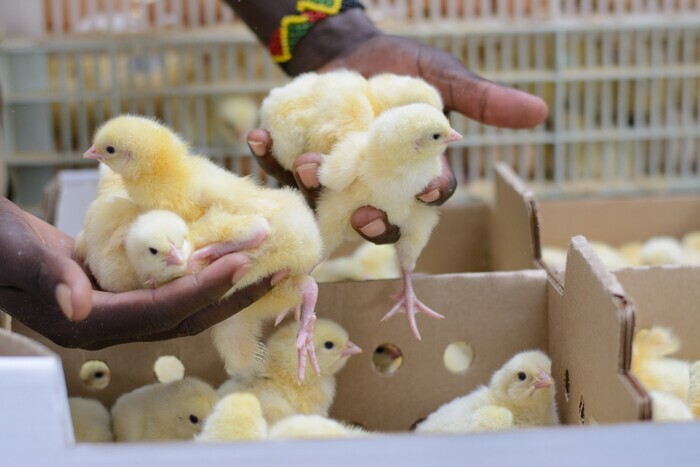
Introduction
Creating the ideal housing conditions for day old broiler chicks is essential for their growth, health, and overall productivity. Proper brooder setup, temperature control, ventilation, and space requirements play a crucial role in ensuring the well-being of the chicks. This article discusses the best practices for broiler chick housing to help poultry farmers provide optimal living conditions.
Brooder Setup
Location and Design
Choose a well-ventilated location for the brooder, away from drafts and predators. The brooder should be designed to allow easy access for cleaning and monitoring the chicks.
Brooder Equipment
Essential brooder equipment includes:
- Heat Source: Use heat lamps, infrared heaters, or brooder stoves to maintain the required temperature.
- Litter: Use absorbent materials like wood shavings or straw to keep the brooder dry and comfortable.
- Feeders and Drinkers: Provide sufficient feeders and drinkers to ensure all chicks have access to food and water.
Lighting
Provide continuous lighting for the first 48 hours to help chicks locate food and water. After this period, maintain a 23-hour light and 1-hour dark cycle to promote growth and development.
Temperature Control
Temperature Requirements
Maintaining the correct temperature is crucial for the survival and growth of broiler chicks. The recommended temperature settings are:
- Temperature must be stabilized 24 hours before chicks arrive at the farm. The ideal temperature for day-old chicks is between 32°C and 35°C. Lower the temperature every second day by ½ degree Celsius. At 28 to 42 days, a temperature of 20°C is ideal.
Monitoring Temperature
Use thermometers to monitor the temperature at chick level. Adjust heat sources as needed to maintain the optimal temperature. Observe chick behavior; if they huddle under the heat source, they are too cold. If they move away from the heat, they are too hot.
Ventilation
Importance of Ventilation
Proper ventilation is essential to remove excess moisture, ammonia, and carbon dioxide from the brooder. Good ventilation also helps regulate temperature and humidity levels.
Ventilation Methods
- Natural Ventilation: Use windows, vents, and fans to promote air circulation.
- Mechanical Ventilation: Install exhaust fans and air inlets to ensure consistent airflow.
Space Requirements
Stocking Density
Overcrowding can lead to stress, poor growth, and increased disease risk. Follow these guidelines for stocking density:
- First Week: 30 chicks per square meter
- Second Week: 20 chicks per square meter
- Third Week and Beyond: 8-10 chicks per square meter
Brooder Size
Ensure the brooder is large enough to accommodate the growing chicks. Provide additional space as the chicks grow to prevent overcrowding.
Hygiene and Biosecurity
Cleaning and Disinfection
Regularly clean and disinfect the brooder to prevent disease outbreaks. Remove wet or soiled litter and replace it with fresh, dry material. Clean feeders and drinkers daily to maintain hygiene.
Biosecurity Measures
Implement biosecurity measures to protect the chicks from disease. Limit access to the brooder area, disinfect footwear and equipment, and isolate new or sick birds.
Conclusion
Providing optimal housing conditions for day-old broiler chicks is essential for their growth and well-being. By setting up a proper brooder, maintaining the correct temperature, ensuring good ventilation, and following appropriate space requirements, poultry farmers can create a healthy environment for their chicks. Alfa Chicks is dedicated to supporting farmers with high-quality chicks and expert advice to ensure the success of their poultry operations.
References
Optimal housing conditions are vital for the health and productivity of broiler chicks. By following these best practices, farmers can provide a safe and nurturing environment for their flock.